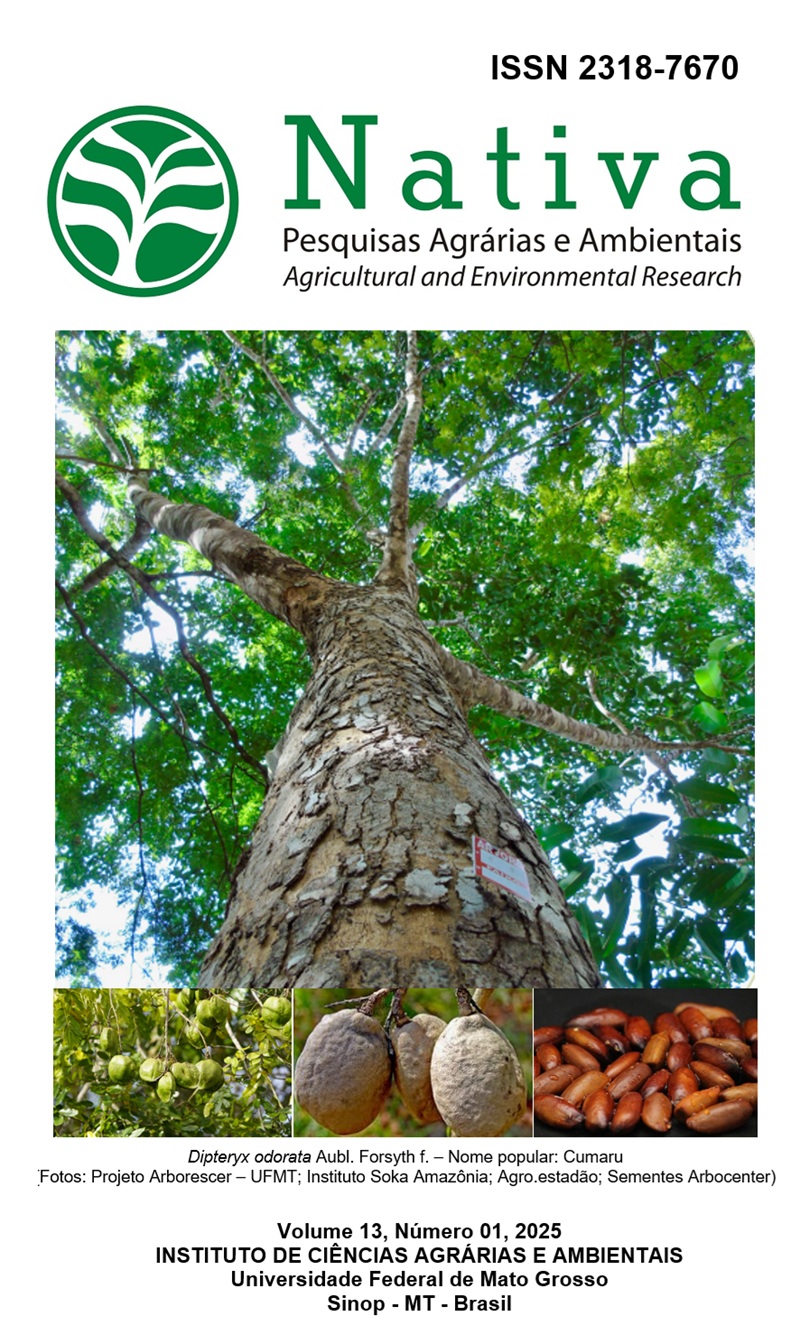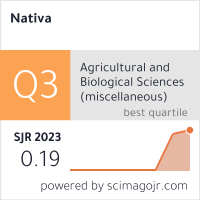SOBREVIVÊNCIA E CAPACIDADE DE VOO DE Apis mellifera APÓS EXPOSIÇÃO DIRETA A EXTRATOS AQUOSOS DE NIM
DOI:
https://doi.org/10.31413/nat.v13i1.18465Palavras-chave:
Abelha melífera, Conservação, Mortalidade, Azadirachta indicaResumo
Conhecer a toxicidade dos inseticidas, inclusive naturais, sobre Apis mellifera é fundamental para conservação dessa abelha nas áreas de produção agrícola. Portanto, objetivou-se avaliar a toxicidade de extratos aquosos de nim sobre A. mellifera, via pulverização direta. O bioensaio foi realizado sob condições de laboratório, sendo avaliadas três doses do extrato aquoso de folhas de nim (5, 10 e 20 g 100mL-1) e três doses do extrato aquoso de sementes de nim (5, 10 e 20 g 100mL-1). Foram avaliadas a mortalidade e os efeitos adversos sobre o comportamento das abelhas por um período de 24 horas, bem como sua capacidade de voo após o período de exposição. Os extratos aquosos de nim ocasionaram mortalidade entre 8,2% e 27,4% para folhas e 15,4% e 24,3% para sementes. O Tempo letal mediano (TL50) proporcionado pelos extratos aquosos de nim foi de 269,69 horas para folha na dose 5g 100mL-1, 135,39 horas para folha nas doses 10 e 20g 100mL-1, e 67,89 horas para semente independente da dose. Não foram observados distúrbios motores e não houve interferência na capacidade de voo de A. mellifera. Os extratos aquosos de folhas e sementes de nim, nas concentrações avaliadas, foram pouco tóxicos sobre A. mellifera.
Palavras-chave: abelha melífera; conservação; mortalidade; Azadirachta indica.
Survival and flight capacity of Apis mellifera after direct exposure to aqueous extracts of neem
ABSTRACT: Understanding the toxicity of insecticides, including those derived from natural sources, on Apis mellifera is crucial for conserving this bee in agricultural production areas. Therefore, this study aimed to evaluate the toxicity of aqueous neem extracts on A. mellifera via direct spraying. The bioassay was carried out under laboratory conditions, evaluating three doses of aqueous extract of neem leaves (5, 10 and 20 g 100mL-1) and three doses of aqueous extract of neem seeds (5, 10 and 20 g 100mL-1). Mortality and adverse effects on bee behavior were evaluated for 24 hours as well as their capacity to fly after exposure. Neem aqueous extracts caused mortality between 8.2% and 27.4% for leaves and 15.4% and 24.3% for seeds. The median lethal time (TL50) occasioned by aqueous neem extracts was 269.69 hours for the leaf at a dose of 5 g 100mL-1, 135.39 hours for the leaf at doses of 10 and 20 g 100mL-1, and 67.89 hours for the seed regardless of dose. No motor disturbances were observed, and there was no interference with A. mellifera capacity to fly. Aqueous extracts of neem leaves and seeds were low toxic to A. mellifera at the concentrations evaluated.
Keywords: honey bee; conservation; mortality; Azadirachta indica.
Referências
ABBOTT, W. S. A method of computing the effectiveness of an insecticide. Journal of Economic Entomology, v. 18, n. 1, p.265-267, 1925.
AMARAL, R. L.; VENZON, M.; MARTINS FILHO, S.; LIMA, M. A. P. Does ingestion of neem-contaminated diet cause mortality of honey bee larvae and foragers? Journal of Apicultural Research, v. 54, n. 4, p. 405-410, 2015. https://doi.org/10.1080/00218839.2016.1159821
BARBOSA, W. F.; SMAGGHE, G.; GUEDES, R. N. C. Pesticides and reduced risk insecticides, native bees and pantropical stingless bees: pitfalls and perspectives. Pest Management Science, v. 71, n. 8, p. 1049-1053, 2015. https://doi.org/10.1002/ps.4025
BLEICHER, E.; GONÇALVES, M. E. C.; SILVA, L. D. Efeito de derivados de nim aplicados por pulverização sobre a mosca-branca em meloeiro. Horticultura Brasileira, v. 25, n. 1, p. 110-113, 2007. https://doi.org/10.1590/S010205362007000100022
CATANIA, R.; LIMA, M. A. P.; POTRICH, M.; SGOLASTRA, F.; ZAPPALÁ, L.; MAZZEO, G. Are botanical biopesticides safe for bees (Hymenoptera, Apoidea)?. Insects, v. 14, n. 3, e0247, 2023. https://doi.org/10.3390/insects14030247
COSTA, E. M.; ARAUJO, E. L.; MAIA, A. V. P.; SILVA, F. E. L.; BEZERRA, C. E. S.; SILVA, J. G. Toxicity of insecticides used in the Brazilian melon crop to the honey bee Apis mellifera under laboratory conditions. Apidologie, v. 45, n. 1, p. 34-44, 2014. https://doi.org/10.1007/s13592-013-0226-5
COSTA, E. M.; SILVA, F. E. L.; ARAUJO, E. L. Effect of aqueous neem seed extract via irrigation on larvae of Liriomyza sativae in melon crop. Horticultura Brasileira, v. 36, n. 3, p. 353-356, 2018. https://doi.org/10.1590/s0102-053620180311
COSTA, E. M.; TORRES, S. B.; FERREIRA, R. R.; SILVA, F. G. D.; ARAUJO, E. L. Extrato aquoso de sementes de nim no controle de Liriomyza sativae (Diptera: Agromyzidae) em meloeiro. Revista Ciência Agronômica, v. 47, p. 401-406, 2016. https://doi.org/10.5935/1806-6690.20160048
FERNANDES, S. R.; BARREIROS, L.; OLIVEIRA, R. F.; CRUZ, A.; PRUDÊNCIO, C.; OLIVEIRA, A. I.; PINHO, C.; SANTOS, N.; MORGADO, J. Chemistry, bioactivities, extraction and analysis of azadirachtin: State-of-the-art. Fitoterapia, v .134, p. 141-150, 2019. https://doi.org/10.1016/j.fitote.2019.02.006
FARRUGGIA, F. T.; GARBER, K.; HARTLESS, C.; JONES, K.; KYLE, L.; MASTROTA, N.; MILONE, J. P.; SANKULA, S.; SAPPINGTON, K.; STEBBINS, K.; STEEGER, T.; SUMMERS, H.; THOMPSON, P. G.; WAGMAN, M. A retrospective analysis of honey bee (Apis mellifera) pesticide toxicity data. Plos One, v. 17, n. 4, e0265962, 2022. https://doi.org/10.1371/journal.pone.0265962
GOMES, I. N.; VIEIRA, K. I. C.; GONTIJO, L. M.; RESENDE, H. C. Honeybee survival and flight capacity are compromised by insecticides used for controlling melon pests in Brazil. Ecotoxicology, v. 29, p. 97-107, 2020. https://doi.org/10.1007/s10646-019-02145-8
HABARUREMA, G.; HABINSHUTI, J.; MUKARUNYANA, B.; UWAMARIYA, C.; SAFARI, J. C.; NDAYAMBAJE, J. B. Activity assay of neem products as pest antifeedant in agro‐biodiversity. International Journal of Tropical Insect Science, v. 42, p. 109-115, 2022. https://doi.org/10.1007/s42690-021-00523-6
HAMMER, O.; HARPER, D. A. T.; RYAN, P. D. Past: Paleontological statistics software package for education and data analysis. Paleontologia Electronica, v. 4, n. 1, p. 1-9, 2001.
HASSAM, U. A.; GULZAR, A.; RASSOL, B.; ZAFAR, S.; YOUNIS, T.; SHAKEEL, M.; KHAN, D.; ULLAH, S.; KHALIQ, S.; AHMAD, S. F.; HAFEEZ, M. Efficacy of Citrullus colocynthis seed extract on Earias vittella, Fabricius, (Lepidoptera: Noctuidae): environment sustainable approach. Brazilian Journal of Biology, v. 84, p. 1-10, 2024. https://doi.org/10.1590/1519-6984.254479
KAMUNHUKAMWE, T.; NZUMA, J. K.; MAODZEKA, A.; GANDAWA, C. G.; MATONGERA, N.; MADZINGAIDZO, L.; MUTURIKI, L. Efficacy of neem bio-pesticide and synthetic insecticides against control of fall armyworm (Spodoptera frugiperda) in Maize. Journal of Entomology and Zoology Studies, v. 10, n. 4, p. e9018, 2022. https://doi.org/10.22271/j.ento.2022.v10.i4b.9018
KAUR, G.; SINGH, R.; SINGH, A. Impact of neem oil on developmental stages of honey bee Apis mellifera L. Indian Journal of Entomology, v. 84, n. 4, p. 783-787, 2022. https://doi.org/10.55446/IJE.2021.133
KHALIFA, S. A. M.; ELSHAFIEY, E. H.; SHETAIA, A. A.; EL-WAHED, A. A. A.; ALGETHAMI, A. F.; MUSHARRAF, S. G.; ALAJMI, M. F.; ZHAO, C.; MASRY, S. H.; ABDEL-DAIM, M. M.; HALABI, M. F.; KAI, G.; AL NAGGAR, Y.; BISHR, M.; DIAB, M. A. M.; EL-SEEDI, H. R. Overview of Bee Pollination and Its Economic Value for Crop Production. Insects, v. 12, n. 8, e688, 2021. https://doi.org/10.3390/insects12080688
KLEIN, A. M.; FREITAS, B. M.; BOMFIM, G. A.; BOREUX, V.; FORNOFF, F.; OLIVEIRA, M. O. A polinização agrícola por insetos no Brasil. Um guia para fazendeiros, agricultores, extensionistas, políticos e conservacionistas. Albert-Ludwigs University Freiburg, Nature Conservation and Landscape. Ecology. 2020. 149p. Disponível em: https://doi.org/10.6094/UNIFR/151237
LUNARDI, J. S.; ZALUSKI, R.; ORSI, R. O. Evaluation of motor changes and toxicity of insecticides fipronil and imidacloprid in Africanized honey bees (Hymenoptera: Apidae). Sociobiology, v. 64, n. 1, p. 50-56, 2017. https://doi.org/10.13102/sociobiology.v64i1.1190
PASCOLI, M.; JACQUES, M. T.; AGARRAYUA, D. A.; AVILA, D. S.; LIMA, R.; FACETO, L. F. Neem oil based nanopesticide as an environmentally-friendly formulation for applications in sustainable agriculture: An ecotoxicological perspective. Science of the Total Environment, v. 677, p. 57-67, 2019. https://doi.org/10.1016/j.scitotenv.2019.04.345
PIRES, J. N.; ARBOITTE, M. Z.; PEREIRA, V. A.; PENZENHAGEN, N. V.; ANDERSSON, F. S. Toxicidade do óleo de Neem e do extrato de alho para Apis mellifera L. Revista de Ciência e Inovação, v. 10, n. 1, p. 1-18, 2024. https://doi.org/10.26669/2448-4091.2024.463
R DEVELOPMENT CORE TEAM. R: A language and environment for statistical computing. R Foundation for Statistical Computing, 2022. <http://www.r-project.org/>.
SCHMUTTERER, H. Properties and potential of natural pesticides from neem tree. Annual Review of Entomology, v. 35, p. 271-297, 1990. https://doi.org/10.1146/annurev.en.35.010190.001415
SILVA, A. B.; BATISTA, J. L.; BRITO, C. H. Atividade inseticida do nim (Azadiractha indica A. Juss). Revista Verde de Agroecologia e Desenvolvimento Sustentável, v. 4, p. 7-15, 2009.
SINGLA, A.; BARMOTA, H.; SAHOO, S. K.; KANG, B. K. Influence of neonicotinoids on pollinators: A review. Journal of Apicultural Research, v. 60, p. 19-32, 2020. https://doi.org/10.1080/00218839.2020.1825044
SOUZA, C. O.; TEIXEIRA, V. W.; CRUZ, G. S.; GUEDES, C. A.; NASCIMENTO, J. C. S.; LAPA NETO, C. J. C.; TEIXEIRA, A. A. C. Toxicology, histophysiological and nutritional changes in Apis mellifera (Hymenoptera: Apidae) submitted to limonene and natural pesticides in comparison to synthetic pesticides. Journal of Apicultural Research, v. 63, n. 5, p. 912-923, 2024. https://doi.org/10.1080/00218839.2023.2166229
TOSI, S.; SFEIR, C.; CARNESECCHI, E.; VANENGELSDORP, D.; CHAUZAT, M. P. Lethal, sublethal, and combined effects of pesticides on bees: A meta-analysis and new risk assessment tools. Science of the Total Environment, v. 844, p. 1-12, 2022. https://doi.org/10.1016/j.scitotenv.2022.156857.
XAVIER, V. M.; PICANÇO, M. C.; CHEDIAK, M.; JÚNIOR, P. A. S.; RAMOS, R. S.; MARTINS, J. C. Acute toxicity and sublethal effects of botanical insecticides to honey bees. Journal of Insect Science, v. 15, n. 1, p. 137, 2015. https://doi.org/10.1093/jisesa/iev110
Downloads
Publicado
Edição
Seção
Como Citar
Licença
Copyright (c) 2025 Nativa

Este trabalho está licenciado sob uma licença Creative Commons Attribution-NonCommercial 4.0 International License.
Direitos Autorais para artigos publicados nesta revista são do autor, com direitos de primeira publicação para a revista. Em virtude de a aparecerem nesta revista de acesso público, os artigos são de uso gratuito, com atribuições próprias, em aplicações educacionais e não-comerciais.
A artigos publicados nessa revista, podem ser reproduzidos parcialmente ou utilizados como referência por outros autores, desde que seja cita a fonte, ou seja, a Revista Nativa.
Copyright for articles published in this journal are the authors, with first publication rights granted to the journal. The journal shows open access, and articles are free to use, with proper attribution, in educational and non-commercial.
The articles published in this journal may be reproduced in part or used as a reference by other authors, provided that the source is quoted.






